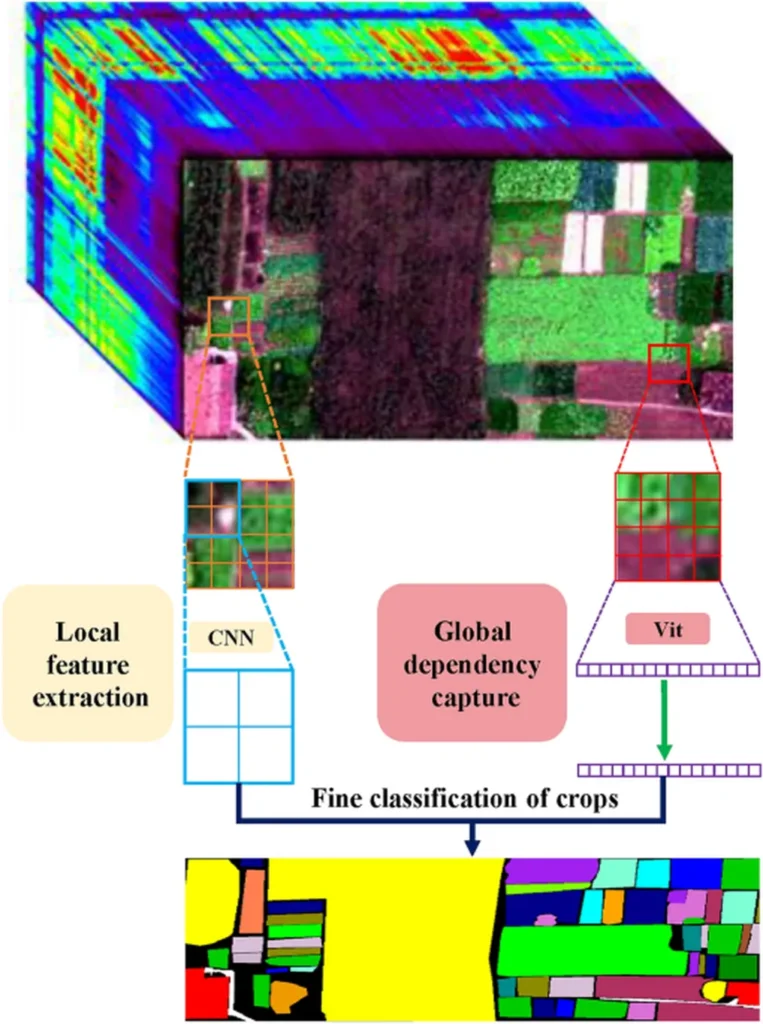In the rapidly evolving world of precision agriculture, a groundbreaking study led by Weizhen Zhang from the College of Information Science and Engineering at Henan University of Technology in Zhengzhou, China, is set to revolutionize crop classification using hyperspectral remote sensing. The research, published in the journal *Geo-spatial Information Science* (translated from its original Chinese title), introduces an innovative model called Hybrid-KANet, which promises to enhance the accuracy and efficiency of crop identification, potentially transforming the agricultural landscape.
Hyperspectral remote sensing involves capturing images across hundreds of narrow, contiguous spectral bands, providing a wealth of data that can be used to identify and classify crops with high precision. However, traditional methods often struggle to model the complex nonlinear feature distributions in this data, limiting their effectiveness. Zhang and his team have addressed this challenge by developing Hybrid-KANet, an improved model based on the Kolmogorov-Arnold network (KAN).
“The Hybrid-KANet model introduces a 3D fast kernel-activated convolutional layer and replaces traditional linear activation functions with a radial basis function (RBF),” explains Zhang. “This allows the model to represent and discriminate complex nonlinear boundaries in hyperspectral images without introducing an attentional mechanism.”
The model’s innovative approach involves fitting using learnable B-spline basis functions, enabling it to adaptively adjust to local features and achieve fine-grained approximation of complex decision boundaries in the input space. This adaptability is crucial for precision agriculture, where accurate crop classification can lead to more efficient resource management, reduced environmental impact, and increased yields.
To validate the effectiveness of Hybrid-KANet, the researchers conducted experiments on two hyperspectral remote sensing datasets: Indian Pines and WHU-Hi-LongKou. The results were impressive, with the model achieving overall classification accuracies of 99.22% and 99.87% on the two datasets, respectively. These accuracies represent significant improvements over the existing HybridSN model, with increases of 1.71% and 0.11%. Additionally, the mean intersection and merger ratio (mIoU) and the Kappa coefficient were also improved, demonstrating the model’s superior performance.
“The ablation experiments demonstrated the advantages of the RBF kernel function in modeling complex nonlinear relationships,” Zhang adds. “This improvement in classification accuracy and spatial consistency is a game-changer for the field.”
The implications of this research extend beyond the agricultural sector. In the energy sector, accurate crop classification can aid in the development of bioenergy crops, optimizing land use for energy production, and ensuring sustainable practices. By providing a more precise and efficient method for crop identification, Hybrid-KANet can support the energy sector’s efforts to transition towards renewable and sustainable energy sources.
As the world grapples with the challenges of climate change and food security, innovations like Hybrid-KANet offer a beacon of hope. By enhancing our ability to manage agricultural resources more effectively, this technology can contribute to a more sustainable and resilient future. The research published in *Geo-spatial Information Science* not only advances the field of precision agriculture but also paves the way for broader applications in environmental monitoring, disaster management, and beyond.
In the words of Zhang, “The Hybrid-KANet model provides theoretical innovation for precision agriculture management and a new solution for hyperspectral remote sensing crop classification.” As we look to the future, the potential of this technology to shape the way we interact with our environment is both exciting and profound.

